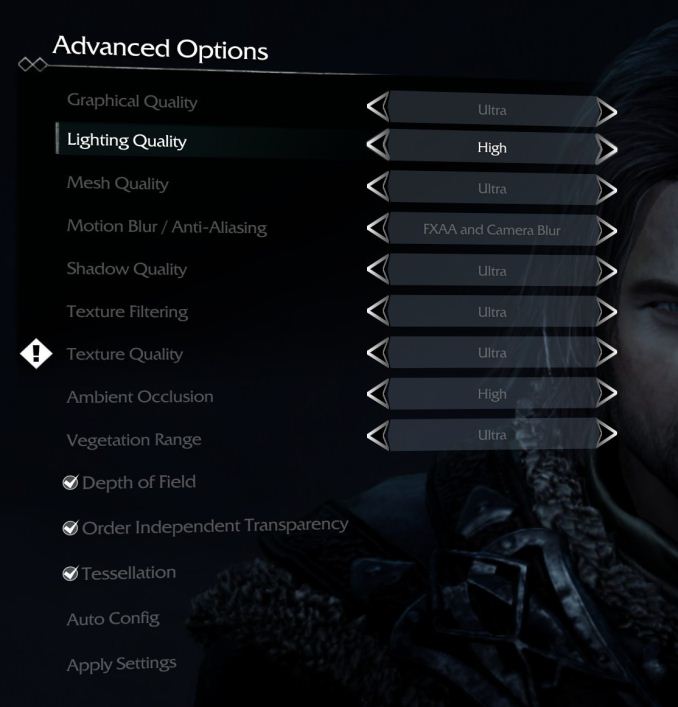Retesting AMD Ryzen Threadripper’s Game Mode: Halving Cores for More Performance
by Ian Cutress on August 17, 2017 12:01 PM ESTShadow of Mordor
The next title in our testing is a battle of system performance with the open world action-adventure title, Middle Earth: Shadow of Mordor (SoM for short). Produced by Monolith and using the LithTech Jupiter EX engine and numerous detail add-ons, SoM goes for detail and complexity. The main story itself was written by the same writer as Red Dead Redemption, and it received Zero Punctuation’s Game of The Year in 2014.
A 2014 game is fairly old to be testing now, however SoM has a stable code and player base, and can still stress a PC down to the ones and zeroes. At the time, SoM was unique, offering a dynamic screen resolution setting allowing users to render at high resolutions that are then scaled down to the monitor. This form of natural oversampling was designed to let the user experience a truer vision of what the developers wanted, assuming you had the graphics hardware to power it but had a sub-4K monitor.
The title has an in-game benchmark, for which we run with an automated script implement the graphics settings, select the benchmark, and parse the frame-time output which is dumped on the drive. The graphics settings include standard options such as Graphical Quality, Lighting, Mesh, Motion Blur, Shadow Quality, Textures, Vegetation Range, Depth of Field, Transparency and Tessellation. There are standard presets as well.
We run the benchmark at 1080p and a native 4K, using our 4K monitors, at the Ultra preset. Results are averaged across four runs and we report the average frame rate, 99th percentile frame rate, and time under analysis.
All of our benchmark results can also be found in our benchmark engine, Bench.
MSI GTX 1080 Gaming 8G Performance

1080p



4K



ASUS GTX 1060 Strix 6G Performance

1080p



4K



Sapphire Nitro R9 Fury 4G Performance

1080p



4K



Sapphire Nitro RX 480 8G Performance

1080p



4K















104 Comments
View All Comments
peevee - Friday, August 18, 2017 - link
Compilation scales even on multi-CPU machines. With much higher communication latencies.In general, compilers running in parallel on MSVC (with MSBuild) run in different processes, they don't write into each other's address spaces and so do not need to communicate at all.
Quit making excuses. You are doing something wrong. I am doing development for multi-CPU machines and ON multi-CPU machines for a very long time. YOU are doing something wrong.
peevee - Friday, August 18, 2017 - link
BTW, when you enable NUMA on TR, does Windows 10 recognize it as one CPU group or 2?gzunk - Saturday, August 19, 2017 - link
It recognizes it as two NUMA nodes.Alexey291 - Saturday, September 2, 2017 - link
They aren't going to do anything.All their 'scientific benchmarking' is running the same macro again and again on different hardware setups.
What you are suggesting requires actual work and thought.
Arbie - Thursday, August 17, 2017 - link
As noted by edzieba, the correct phrase (and I'm sure it has a very British heritage) is "The proof of the pudding is in the eating".Another phrase needing repair: "multithreaded tests were almost halved to the 1950X". Was this meant to be something like "multithreaded tests were almost half of those in Creator mode" (?).
Technically, of course, your articles are really well-done; thanks for all of them.
fanofanand - Thursday, August 17, 2017 - link
Thank you for listening to the readers and re-testing this, Ian!ddriver - Thursday, August 17, 2017 - link
To sum it up - "game mode" is moronic. It is moronic for amd to push it, and to push TR as a gaming platform, which is clearly neither its peak, nor even its strong point. It is even more moronic for people to spend more than double the money just to have half of the CPU disabled, and still get worse performance than a ryzen chip.TR is great for prosumers, and represents a tremendous value and performance at a whole new level of affordability. It will do for games if you are a prosumer who occasionally games, but if you are a gamer it makes zero sense. Having AMD push it as a gaming platform only gives "people" the excuse to whine how bad it is at it.
Also, I cannot shake the feeling there should be a better way to limit scheduling to half the chip for games without having to disable the rest, so it is still usable to the rest of the system.
Gothmoth - Thursday, August 17, 2017 - link
first coders should do their job.. that is the main problem today. lazy and uncompetent coders.eriohl - Thursday, August 17, 2017 - link
Of course you could limit thread scheduling on software level. But it seems to me that there is a perfectly reasonable explanation why Microsoft and the game developers haven't been spending much time optimizing for running games on systems with NUMA.HomeworldFound - Thursday, August 17, 2017 - link
You can't call a coder that doesn't anticipate a 16 core 32 thread CPU lazy. The word is incompetent btw. I'd like to see you make a game worth millions of dollars and account for this processor, heck any processor with more than six cores.